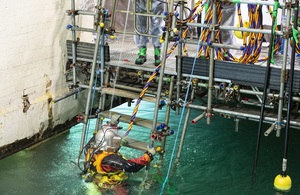Sellafield clean-up team dives into history
A team of specialist nuclear divers is carrying out vital clean-up and decommissioning work in the oldest legacy storage pond on the Sellafield site.

Josh Everett, a diver from the specialist U.S nuclear diving team Underwater Construction Corporation Ltd, became the first person in over 60 years to descend the ladder and set to work in one of the most unique workplaces in the world.
The last time a human entered Sellafield’s Pile Fuel Storage Pond was in 1958, when records show a maintenance operator and health physics monitor carried out a dive into the newly constructed pond to repair a broken winch.
At least that was true until December 2022 when Josh Everett, a diver from the specialist U.S nuclear diving team Underwater Construction Corporation Ltd, became the first person in over 60 years to work in one of the most unique workplaces in the world.
Video - The Divers in the Pile Fuel Storage Pond
The Pile Fuel Storage Pond is one of the oldest buildings on the Sellafield site and was constructed in the 1940s to support the operation of the Windscale Piles; the first nuclear reactors to be built at Sellafield.
The 100 metre long outdoor pond was used for the cooling, storage, and de-canning of spent fuel from the reactors as part of the UK’s post-war atomic weapons programme.
Operations ceased in the 1960s and in the years that followed sludges formed from the decaying nuclear fuel, algae and other debris.
In the last decade significant progress has been made in retrieving and safely storing fuel, bulk sludges and redundant equipment from the pond, but it remains one of the most complex decommissioning challenges in the world and a priority project for Sellafield Ltd and the Nuclear Decommissioning Authority (NDA).
Divers enter the pond via a specially installed access platform and position themselves on a metal dive stand with a shielded floor.
From here they were able to work in shifts of up to 3.5 hours at a time to retrieve sludges and debris from the pond floor, corners and other hard-to-reach areas.
Sending human divers into a contaminated pond may seem to run counter to modern nuclear clean-up and decommissioning techniques that commonly use robots and other tools for this type of work, but these are no ordinary divers.
Josh and his team have years of experience in safely diving in radioactive environments around the world, including at Dungeness A and Sizewell A in the UK.
Lessons learned at these Magnox sites have been applied to the team’s work at the Pile Fuel Storage Pond, which still presents some unique challenges owing to its age and complexity.
In turn the experiences of the team at the Pile Fuel Storage Pond will help inform investigations into how divers might contribute to the clean-up and dewatering of other nuclear ponds in the future.
Carl Carruthers, Sellafield Ltd head of programme delivery for legacy ponds, said:
The Pile Fuel Storage Pond diver project has been 5 years in the planning and has been a huge success. The team are used to diving in toxic and hazardous environments all over the world, including inside nuclear reactor vessels, but this is a first for us.
Safety has been our priority throughout, and the divers are monitored and communicating with the dive supervisor at all times.
Their work has helped us make real progress in cleaning up the pond and our site mission to deal with the nuclear legacy and create a clean and safe environment for future generations.
Once all of the waste materials have been removed from the pond the water will be removed, ready for final demolition of the building.
Current plans estimate the decommissioning work will cost around £212 million and will be completed by 2039, an achievement almost a century in the making.
David Redpath, NDA director of performance improvement - Sellafield, said:
The success of the Pile Fuel Storage Pond diver project is an important decommissioning milestone for Sellafield Ltd and a really positive example of sharing learning to overcome common challenges on sites across the NDA group.
It’s a testament to the skill and expertise of both Sellafield and the diving team and demonstrates how we are utilising innovative techniques to ensure the UK’s legacy nuclear waste is dealt with safely and securely.
Alan Wylie, Office for Nuclear Regulation superintending inspector, said:
Our specialist inspectors assessed Sellafield Ltd’s safety submission and were satisfied that it is safe for divers to enter and work in the pond.
The use of divers has allowed Sellafield Ltd to make progress with retrieving the remaining material from bays 11 and 12, which existing retrieval techniques are no longer able to do.
Our inspectors will continue to monitor the retrievals work from this facility as part of our inspection activities on the Sellafield site.